Pindi Memoirs by a Sikh Son of the Soil -2
Category:
Tags:
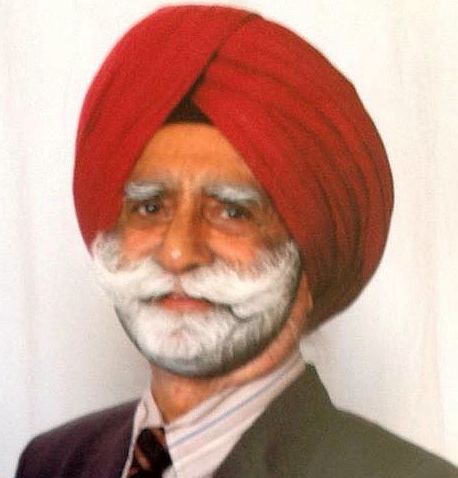
Kanwarjit Singh Malik was born in Rawalpindi in 1930. His family moved to India at the time of Partition in 1947. He joined the Flying Club in Jalandhar, and was later selected by the Indian Air Force. After the retirement from the Air Force, he served as a senior captain in Air India and Air Lanka. He got married in 1961, and now lives in Mumbai with his wife.
Editor's note: This is a slightly edited version of an article that originally appeared at http://nativepakistan.com/pindi-memoirs-by-a-sikh-son-of-the-soil-part-2-rawalpindi-blog/, and is reproduced here with the author's permission. Part 1 is available here.
The details in this article are as told to me by my eldest brother Bhupinder Singh Malik, and my father Malik Mukhbain Singh, Bar-at-law.
Our family of Ahluwalia Sikhs came from district Gujrat and settled in village Dera Khalsa and Dwalian (Tehsil Kahota, District Rawalpindi), which was gifted by the Muslim rulers of that time with title (Malik). My great-grandfather, Malik Khazan Singh, was born in Dera Khalsa in 1813. At the age of 20 or 25, he lost his father. His mother then sent him to Pindi with Rs.25.
He decided to join Maharaja Ranjit Singh's army, with which he served and travelled up to Kabul, gaining experience. Then, he left the army and set up own business\; by then the regions was controlled by the British. He married late. He had four sons and two daughters. His very close Malik relatives settled in Abbottabad, Ferozepur and some other parts of India. All were doing well and built up huge properties and lands in different Canal Colonies and in the cities of Pindi, Abbottabad, Lahore, Ferozepur and Delhi. Fourteen of his grandsons were educated abroad, and they were then the most foreign-educated family of Pindi. They were mostly doctors, engineers, lawyers, hoteliers, etc. He passed away in 1899.
My grand-uncle, Mohan Singh Malik, lived at 40 Edwards Road (now Bank Road) in Rawalpindi Saddar (Cantt). His eminent sons were Sir Teja Singh Malik (ISE), Hardit Singh Malik (ICS), and I S Malik (Member, Railway Board).
My father, Malik Mukhbain Singh, suffered from polio when he was 2 or 3 years old. He was treated in the UK, while he was studying Law, but his condition did not improve. He was fitted with a brace, which he used to wear while going outside, and always walked with a stick.

During his studies in Law in the UK, my father befriended many well-known personalities of that time. Pandit Nehru, Veer Savarkar, Dr. Kitchlew, Sir Sikandar Hayat Khan and so many other people were his contemporaries. So were the sons of the Sultans of Turkey who wanted to take him to Turkey and make him a Judge there (he used to tell us that he might have become a Muslim or have been killed during the revolution in Turkey). He was also the secretary of the students' Majlis in the UK.
My father served with Sikh Gurdwara Judicial Commission for 13 years (1934-1947), initially as the member and later Chairman for seven years. Sir Sikandar Hayat, Nawab Muzaffar Khan and so many other Muslims of prominence at that time were his friends, and were regular visitors to our house at Mazang Road, in Lahore. Once Sir Sikandar Hayat (the Premier of undivided Punjab) visited us in Mazang Road, Lahore and gave me Rs. 5 to buy kites and reels. My father also used to settle disputes of nearby Muslim villages\; his word was final, such was his influence, even though he was not a Muslim.
My father was also a Judge in the Princely State of Kapurthala. Due to too much work, he fell sick, and returned to Rawalpindi in 1947.
He never wanted to leave Pindi when Partition was announced. He witnessed the riots in April 1947, and the in August 1947. He was advised by his Muslim friends to leave Pindi. When he immigrated, he had only Rs. 300 in his pocket, and nothing else. All his property including running business, houses, car and tonga were left behind. He also had a bungalow at the Mall Road, in Pindi Cantonment, which today houses the office of PIA. My father passed away in Delhi in 1988 at age 105.
My father's suits were stitched in Lahore by Rankins Tailors, and ours in Pindi by Mohammed Shafi on Dhakki (Purana Qila). At times, we used to buy shoes from the Chinese, the latest trend then being crepe soles. For my mother and all other Malik ladies and so many others, Khaim Din was the shoemaker, with velvet and tilla in silver and gold jutis (shoes). One Pandit Noordin used to come from Srinagar selling shawls. Almost, all the Malik ladies in Pindi used to buy shawls from him. His son later became the Judge of the Srinagar High Court but Pandit Noordin's shop is still there on the Bund in Srinagar.
Our baradri's (community) Naee (messenger) was also named Khaim Din, a very old man. Be it summer or winter, he always wore a black achkan. He used to convey news of birth, death, marriage or any other function in Ahluwalia/Malik baradri and also distribute Shagun and take it all down in a register. As he was a very old man, my father always used to make him sit next to him with tea and mithai/biscuits, and ask about the welfare of others.
From our bungalow at Chowk Saidpur Road (located at the junction of Saidpur Road /Asghar Mall Road, we either went walking or cycling to school. If it was raining, mother used to send the car if father was in Pindi or by our tonga with a Pathan coachman.
Opposite Sanatan Dharam High School (now Government Asghar Mall College), there was a very big Maidan (ground). Villagers from around our area, dancing with the beats of Dhols (Drums) used to bring Bateras/Partridges/Dogs/Goats and bulls and Asli Kukkars for fights. They must have been betting on them too. The site for us urchins was interesting but gory, leading to horrible dreams at night. A man named Billa Kutian Wala used to organize and take active part in it. I believe he had committed some murders too. Once it was reported to my mother that I went to that ground, and she slapped me for going there. I still remember that. After that, I never went there.

Saidpur Road extended up to Chowk Bani Mai Veeran, where it joined Circular Road. On the left, little further away, was Mandir Kalyan Das. It had a big tank, which I once saw, and quite a big Mandir with deities. On the right side was Jamia Masjid Road on which were located several houses of Muslims, and Hakims. Some shops also belonged to Muslims. The road extended to Shah Nazar Pull (Bridge) and beyond where it joined Nehru Road (now Jinnah Road).
Across Shah Nazar Pull were the houses owned by Hindus and Sikhs. Three of those houses belonged to our near relations: Sardar Vasawa Singh (my father's uncle), Munsif Sahab and his brother. The gali (lane) from Munsif Sahab's house led all the way to Saidpuri Darwaza, where Vada Ghar (house of my great-grandfather, Malik Khazan Singh) was located. Also located there were big havelis of the Sahni family (whose son, Balraj Sahni later became one of India's leading actors), and biggest haveli of Sardar Sujan Singh which extended up to Sarafan Bazaar. This haveli was a landmark in Saidpuri Darwaza (old Pindi). It had many murals, paintings and other items, as I was told by my father. It is very unfortunate that recently the Haveli is in a dilapidated condition.
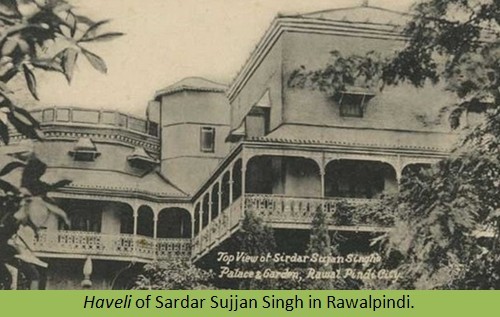
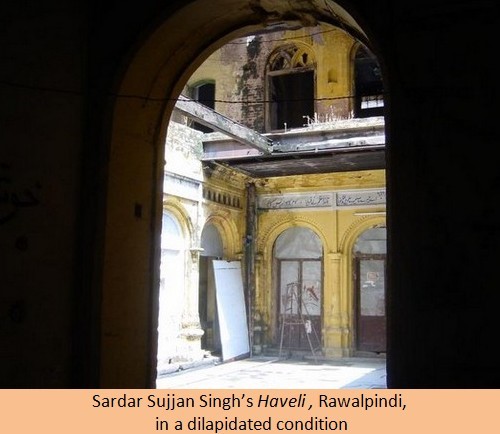
On the way to Saidpuri Darwaza, was Malkan Da Gurdwara. This gurdwara was donated sometime in the early 1900s by one Ahluwalia relation Mai ?? (I am forgetting her name) who became a widow at age 14. At the time of her demise, she willed that her house and whatever she owned go into a fund, for the welfare of the Ahluwalia Baradari's needy persons, especially ladies. Many other relations also contributed to this fund. Munsif Sahab was the fund's manager. At the time of Partition, this fund had lakhs of rupees, and it functions to this day by the contributions of others.
On Nehru Road (now Jinnah Road), after Ganda Nala, there was a Hakim shop of Hakim Asa Nand, and a petrol pump owned by Mr Sobti. Then a Chowk and a road leading to the right\; I never went on this road. There was another road leading to the left. On this road, after one or two houses, was the dispensary of Dr. Ghasita Ram. When we were staying at Nehru Road (before shifting to the new bungalow at Chowk Saidpur), he was our family doctor. He came to our house with a Solar Pith Hat on a bicycle. To me, he looked older than my father did. He always gave me a sweet. Our servants used to carry his bag whenever he visited us. He had 4-5 sons and two daughters\; one of the daughters married Balraj Sahni, who went on to become a famous film personality.

Coming from Nehru Road into Raja Bazaar, just before Raja Bazaar there were two shops of two Sikh Pansari. On the opposite side, was Laxmi Cinema, owned by my grand-uncle, Malik Harnam Singh. Just at the beginning of Raja Bazaar Road, leading to the right was Dingi Khoi around which there were some shops selling Jhatka meat. It also had couple of buses going to nearby towns.
At the beginning of Raja Bazaar, on the right, there were two shops selling soda water of all kinds, and there were two, or three other shops owned by Muslims, also selling soda water and seekh kababs of all kinds. Opposite them, were two or three fruit shops, and a narrow road full of shops going up to Dhakki. After the fruit shops, there were some other small shops, on both sides of the road, selling utensils, rations, etc. And after that the road branched off to Sabzi Mandi, where my maternal uncles lived in a house called Thekedaran Da Ghar. Opposite that house was a very big house belonging to the Sahni family.
Sabzi Mandi Road joined Talwaran Da Bazaar. Before that, there was a well. On the right of the well was another soda water shop.
In Rawalpindi, the Khukrain baradari and Muslims had no differences between themselves, or other Sikhs like Ahluwalias. Everybody lived in peace and harmony. Hindus and Sikhs also came from Kalar Chowki Number 22 like Duggals, and others also from Gujar Khan and Chakwal. All of them were doing well either in contractor business or as shopkeepers.
One road led to Loon Mandi (salt market). After two or three shops, on the left, there was the Gurdwara of Nirankaris of Baba Gurdit Singhji. Inside the compound, on the right was the gurdwara itself, and on the left lived the joint family of Baba Sahab and his two sons, Baba Hara Singh and Baba Sanmukh Singh. The rear door of this gurdwara led into a lane\; I don't remember who lived there.
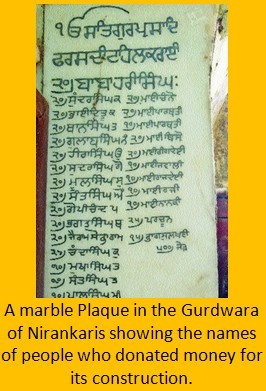
Nirankari was a reformist movement which was started during the period of Maharaja Ranjit Singh. The Gurdwara of Nirankaris is a landmark which is considered as the birthplace of the Nirankari movement. This Gurdwara was established in early 1830s by Baba Dayal Singh, who was the founder of the Nirankari movement. Dayal Singh used to recite the word ‘Narankar' and opposed idol worship. Later, this place became the home for Nirankaris. In 1929, an offshoot group, Sant Nirankari Mission, emerged, led by Boota Singh in Murree. The Gurdwara was not only a worship place but also used to provide shelter to travellers. The wholesale market next to Gurdwara is known as Nirankari Bazaar.
The annual function of Nirankaris used to be held near Topi Rakh, and the Bhagats had their gatherings in Tapaban. I don't remember the exact locations of Topi Rakh and Tapaban. Baba Hara Singh's daughter got married to my eldest brother in April 1947 just after the initial riots in Rawalpindi.
The Sikhs in Pindi migrated to India at the time of Partition, after which their religious places in Pindi were not properly maintained. Unfortunately, in 1958, the double storey building of Gurdwara Nirankari was converted into an educational institute for boys, which is now known as the Government Simla Islamia High School, Namak Mandi, Rawalpindi.
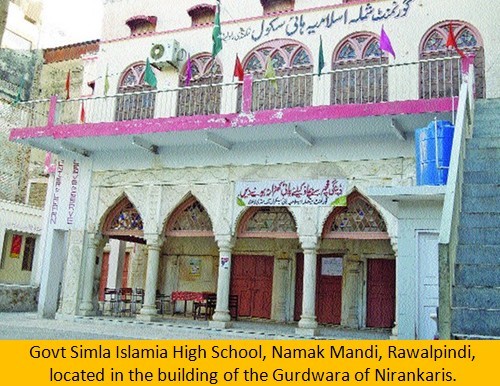
In the Loon Mandi, there were wholesale shops for fruits, pulses and salt from Kohistan-e-Namak in big blocks. Our Gawala (milkman) used to buy those salt blocks and for our animals pewa, khal and channa from Loon Mandi. In our home, we had plenty of fruit, dry fruit, and two boxes of red-blood Khanpuri maltas (oranges).
At the end of Raja Bazaar, on the right side was a big bus stand, with buses going up to Srinagar and other towns. "Chal Brah Muree, Chal Bhen Muree"... these were the shouts, the bus conductors used to make.

In Raja Bazaar, both Hindus, Sikhs and Muslims had their shops, some big, some small, some belonging to Kashmiris (Later, when I was a pilot of Air India, one of our Ministers, Mohammed Shafi, told me on a flight to Riyadh that his father owned a shop in Raja Bazaar, Pindi).
Raja Bazaar ended into a Chowk (now called Fawara Chowk). On the left was Mission High School, where most of the elite of Rawalpindi of the early 1900s studied.
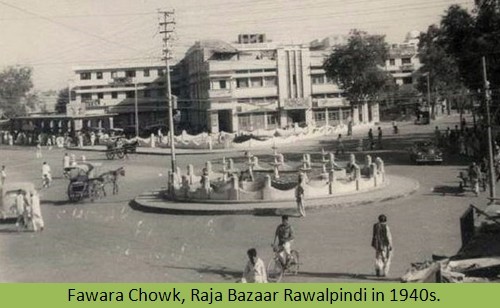
Across was the Rose Cinema, owned by Peshoria Sardar Swaran Singh, and a road leading to Gawal Mandi (for cows and buffaloes). My mother used to visit that Mandi along with our Maali (Gardener) on a tonga to buy a buffalo and cow, at least once in 18 months. I sometimes accompanied her, and wonder why there were so many animals in one place.
After Mission High School, there were big Lakri Taals (wood shops). Mian Aslam and Akram owned quite a few of them. Later, Mian Aslam, my father and Rekhi Sahab (a Sikh gentleman known to my father, from town), took a jungle contract of a block in which each one invested Rs. 5,000. But, soon after, Partition took place and everything was left to Mian Aslam, who lived behind Rose Cinema. Further up from Rose Cinema, was Imperial Cinema which was owned by Jilani Sahab. There was one more cinema, after Imperial Cinema under construction, and maybe newly inaugurated. There were two cinemas in Cantonment, both showed English movies: Capital Cinema and Odeon Cinema (also called Lansdowne Cinema by some people).

[Editor (of Native.Pakistan.com): Sardar Kirpal Singh Rai Bahadar and Sardar Sujan Singh Rai Bhadar founded a trust known as "Lansdowne Trust" in Rawalpindi Cantonment in 1891 with an aim to create entertainment and instruction for the general public.
Lansdowne Trust comprised a cinema building, known as Odeon Cinema, with ancillary apartments and a public library. The Trust was transferred to Cantonment Board in 1897. The Trust was named after Lord Henry Charles Keith Petty-Fitzmaurice, 5th Marquees of Lansdowne, who was Viceroy and Governor General of India from Dec 1888 to Oct 1894. The famous Lansdowne Bridge, Sukkur, (inaugurated in 1889) was also named after him.]
From our bungalow, after Banni, was Circular Road, on which my grandfather's bungalow was located. After that, Sardar Mela Singh Chadha's house and some other houses of Circular Road leading to Gali Chowdry Waris Khan, where Chowdhry Maula Dad and his ancestors lived. My father knew all of them. They were also visitors to our house.
Bedis were the richest residents of Pindi, as they had lots of lands, in different Canal Colonies of Punjab, and owned bungalows and palatial houses in Pindi. Next came, the Khukrain baradari, the Suris, the Sahnis, the Chadhas and others.
Go to Part 3 (to be written).
______________________________________
© Kanwarjit SIngh Malik 2015
Comments
Add new comment